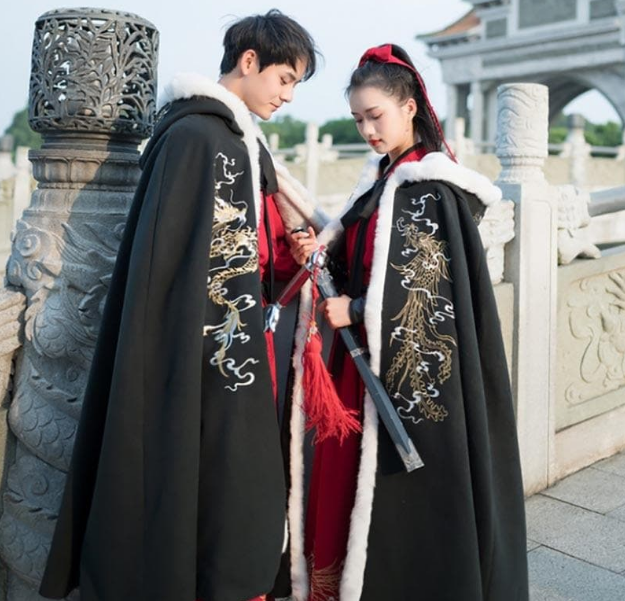Historical Emergence of the Cloak
Early Evidence of Cloak Use
Archaeologists have unearthed cloaks dating back to the Shang dynasty, showcasing silk’s prominence even in early Chinese garments. Texts like the “Book of Documents” reference cloaks worn by nobility, indicating their status symbol. The earliest pieces reveal simple cuts and natural colors, emphasizing functionality over fashion.
Influences on Design and Purpose
The Zhou dynasty saw cloaks evolve with aesthetic and practical enhancements. Warmer regions favored lighter materials like ramie, while colder climates required heavier silk layers. Confucian ideals later introduced cloak modifications to distinguish social ranks, embedding deep cultural significance into the garment’s design.

Materials and Fabrication Techniques
Traditional Fabrics Used
Craftsmen selected silk for its durability and comfort, marking it as a luxury material for cloaks. Hemp served as a more accessible fabric for the masses, known for its breathability and resilience. The choice of fabric often reflected the wearer’s social standing, with silk being associated with wealth and hemp with the common populace.
Ancient Methods of Cloak Construction
Tailors employed meticulous techniques to assemble cloaks, ensuring each piece displayed precision in cut and symmetry. They measured dimensions carefully to fit the wearer, and stitches were fine, often invisible to the naked eye. Cloak makers valued speed in their craft, yet never at the expense of quality, striking a balance between efficiency and artistry.
Symbolism and Social Significance
Cloaks in Royal and Ceremonial Contexts
Kings and court officials donned elaborate cloaks during rituals, embodying divine authority. These garments, often adorned with rare jewels and intricate embroidery, played a crucial role in religious ceremonies, serving as a bridge between the mortal and the divine.
Representation of Status and Wealth
Cloaks became a visual shorthand for wealth, with the finest silk and patterns reserved for the elite. The length and embellishment of a cloak could speak volumes about a person’s social standing. Wealthy individuals would often invest heavily in a cloak’s material and decoration, with costs escalating for those featuring gold threading or dye from precious materials like indigo.
Variations Across Dynasties
Han Dynasty Cloak Styles
During the Han Dynasty, cloaks displayed distinctive features. They were knee-length and made from silk, showcasing intricate embroidery. Officials wore square-shaped cloaks, while the emperor’s had dragon motifs, symbolizing imperial power. These cloaks were an essential part of Han Dynasty attire, reflecting the dynasty’s grandeur and cultural values.
Tang Dynasty Innovations
The Tang Dynasty brought innovations to cloak design. Cloaks became longer, often reaching the ankles, and incorporated wider sleeves, allowing for more freedom of movement. The use of bright, vivid colors became popular, reflecting the dynasty’s cosmopolitan nature and cultural diversity. Innovations in dyeing techniques allowed for a broader range of colors, and patterns included flowers, birds, and mythical creatures. This period marked a fusion of Central Asian and Chinese influences, leading to unique and colorful cloak styles.
Rituals and Etiquette
Rules Governing Cloak Wear
In ancient China, wearing cloaks adhered to strict rules of etiquette. These guidelines dictated when and how to wear a cloak. Cloaks were donned during official ceremonies, emphasizing their role as symbols of authority. High-ranking officials wore specific cloak styles, showcasing their status. The careful selection of cloak color and design conveyed respect for tradition and hierarchy.
Cloaks in Religious Ceremonies
Cloaks played a vital role in religious rituals. Priests and shamans wore cloaks made from sacred materials, reflecting the spiritual significance of the garment. These cloaks were adorned with symbols representing the deities worshipped. Their use in ceremonies created a connection between the earthly and the divine, emphasizing the role of cloaks in facilitating communication with the spiritual realm.
Preservation and Cultural Legacy
Efforts to Preserve Ancient Cloaks
Preserving ancient cloaks involves meticulous care and conservation techniques. Experts employ humidity and temperature controls to maintain fabric integrity. Specialized storage containers protect against pests and light damage. Restoration efforts, often costly, aim to bring damaged cloaks back to their original state. Museums and cultural institutions invest in these preservation measures to safeguard these valuable artifacts.
Influence on Modern Fashion and Culture
Ancient Chinese cloak designs continue to inspire modern fashion. Contemporary designers draw from historical patterns and materials, integrating them into clothing collections. The cultural legacy of cloaks extends to theater, where traditional garments are used in performances, preserving ancient aesthetics. Additionally, educational programs and exhibitions ensure that the historical significance of cloaks remains accessible to the public.







